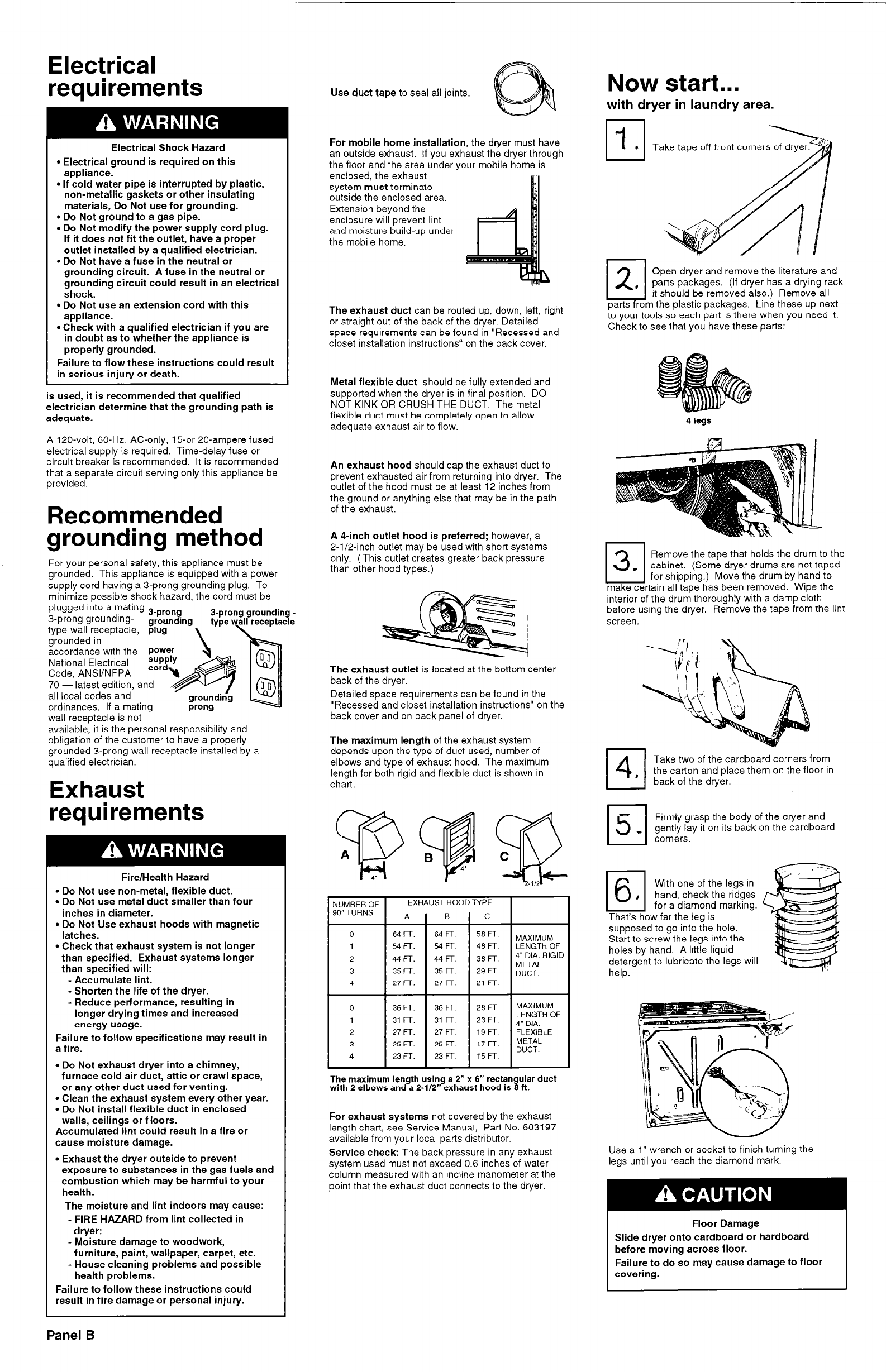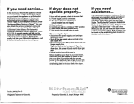
Electrical
requirements
Now start...
Use duct tape to seal all joints.
with dryer in laundry area.
Take tape off front corners of dry
For mobile home installation, the dryer must have
an outside exhaust. If you exhaust the dryer through
the floor and the area under your mobile home is
enclosed, the exhaust
system must terminate
outside the enclosed area.
Extension beyond the
enclosure will prevent lint
and moisture build-up under
the mobile home.
Electrical Shock Hazard
l
Electrical ground is required on this
appliance.
l
If cold water pipe is interrupted by plastic,
non-metallic gaskets or other insulating
materials, Do Not use for grounding.
l
Do Not ground to a gas pipe.
l
Do Not modify the power supply cord plug.
If it does not fit the outlet, have a proper
outlet installed by a qualified electrician.
l
Do Not have a fuse in the neutral or
grounding circuit. A fuse in the neutral or
grounding circuit could result in an electrical
shock.
l
Do Not use an extension cord with this
appliance.
l
Check with a qualified electrician if you are
in doubt as to whether the appliance is
properly grounded.
Failure to flow these instructions could result
in serious injury or death.
I I
E-l
Open dryer and remove the literature and
, parts packages. (If dryer has a drying rack
it should be removed also.) Remove all
parts from the plastic packages. Line these up next
to your tools so each part is there when you need it.
Check to see that you have these parts:
The exhaust duct can be routed up, down, left, right
or straight out of the back of the dryer. Detailed
space requirements can be found in “Recessed and
closet installation instructions” on the back cover.
Metal flexible duct should be fully extended and
supported when the dryer is in final position. DO
NOT KINK OR CRUSH THE DUCT. The metal
flexible duct must be completely open to allow
adequate exhaust air to flow.
is used, it is recommended that qualified
electrician determine that the grounding path is
adequate.
A 120-volt, 60-Hz, AC-only, 15or 20-ampere fused
electrical supply is required. Time-delay fuse or
circuit breaker is recommended. It is recommended
that a separate circuit serving only this appliance be
provided.
An exhaust hood should cap the exhaust duct to
prevent exhausted air from returning into dyer. The
outlet of the hood must be at least 12 inches from
the ground or anything else that may be in the path
of the exhaust.
Recommended
grounding method
A 4-inch outlet hood is preferred; however, a
2-l/2-inch outlet may be used with short systems
only. (This outlet creates greater back pressure
than other hood types.)
0
3
Remove the tape that holds the drum to the
l
cabinet. (Some dryer drums are not taped
for shipping.) Move the drum by hand to
make certain all tape has been removed. Wipe the
interior of the drum thoroughly with a damp cloth
before using the dyer. Remove the tape from the lint
For your personal safety, this appliance must be
grounded. This appliance is equipped with a power
supply cord having a 3-prong grounding plug. To
minimize possible shock hazard, the cord must be
plugged into a mating 3-prong
3-prong grounding-
3-prong grounding -
type wall receptacle, plug
grounded in
grounding, type wee
accordance with the Power
National Electrical
Code, ANSVNFPA
70 - latest edition, and
all local codes and
ordinances. If a mating
prong
The exhaust outlet is located at the bottom center
back of the dryer.
Detailed space requirements can be found in the
“Recessed and closet installation instructions” on the
back cover and on back panel of dyer.
wall receptacle is not
available, it is the personal responsibility and
obligation of the customer to have a properly
grounded 3-prong wall receptacle installed by a
qualified electrician.
The maximum length of the exhaust system
depends upon the type of duct used, number of
elbows and type of exhaust hood. The maximum
length for both rigid and flexible duct is shown in
chart.
u
4
Take two of the cardboard corners from
*
the carton and place them on the floor in
back of the dryer.
Exhaust
requirements
Firmly grasp the body of the dyer and
gently lay it on its back on the cardboard
corners.
0
6
With one of the legs in
4
hand, check the ridges
for a diamond marking.
That’s how far the leg is
supposed to go into the hole.
Start to screw the legs into the
holes by hand. A little liquid
detergent to lubricate the legs will
help.
Fire/Health Hazard
l
Do Not use non-metal, flexible duct.
l
Do Not use metal duct smaller than four
inches in diameter.
l
Do Not Use exhaust hoods with magnetic
latches.
l
Check that exhaust system is not longer
than specified. Exhaust systems longer
than specified will:
- Accumulate lint.
- Shorten the life of the dryer.
- Reduce performance, resulting in
longer drying times and increased
energy usage.
Failure to follow specifications may result in
a fire.
l
Do Not exhaust dryer into a chimney,
furnace cold air duct, attic or crawl space,
or any other duct used for venting.
l
Clean the exhaust system every other year.
l
Do Not install flexible duct in enclosed
walls, ceilings or floors.
Accumulated lint could result in a fire or
cause moisture damage.
l
Exhaust the dryer outside to prevent
exposure to substances in the gas fuels and
combustion which may be harmful to your
health.
The moisture and lint indoors may cause:
- FIRE HAZARD from lint collected in
dryer;
- Moisture damage to woodwork,
furniture, paint, wallpaper, carpet, etc.
- House cleaning problems and possible
health problems.
Failure to follow these instructions could
result in fire damage or personal injury.
NUMBER OF
TYPE
~ c
58FT.
MAXIMUM
48 FT.
LENGTH OF
38 FT.
4” DIA. RIGID
METAL
29 FT.
DUCT.
21 FT.
28 FT.
MAXIMUM
23 FT.
LENGTH OF
4” DIA.
19Fr
FLEXIBLE
17 FT.
METAL
DUCT
15Fr.
EXHAUST HO01
A B
644. 64 FT.
54Fr
54 FT.
t
44FT. 44 Fr
35 FT. 35 FT.
27 FT. 27 FT.
36 FT. 36 FT.
31 FT. 31 FT.
27 FT. 27 IT
25 FT. 25 FT.
23 FT. 23 FT.
The maximu
R length using a 2”
c 6” rectangular duct
with 2 elbow ; and a 2-112” exhal
st hood is 8 ft.
For exhaust systems not covered by the exhaust
length chart, see Service Manual, Part No. 603197
available from your local parts distributor.
Service check: The back pressure in any exhaust
system used must not exceed 0.6 inches of water
column measured with an incline manometer at the
point that the exhaust duct connects to the dryer.
Use a 1” wrench or socket to finish turning the
legs until you reach the diamond mark.
Floor Damage
Slide dryer onto cardboard or hardboard
before moving across floor.
Failure to do so may cause damage to floor
covering.
Panel B







